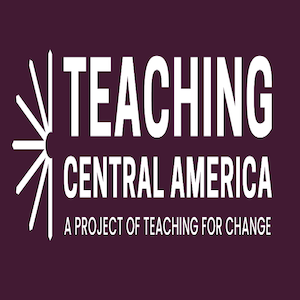Teaching Central America
The history and culture of Central America is often marginalized in US world history curricula. Teaching Central America, created by the nonprofit Teaching for Change, provides educational materials for K-12 educators with the goal of centering Central American history and culture in primary and secondary classrooms. Its team of advisors is comprised of university faculty, artists, K-12 educators, authors, and community activists who work to draw curricular connections between the US and Central America through foreign policy, immigration, commerce, and culture. Teaching Central America provides downloadable lesson plans, literature, poetry, and film suggestions, largely categorized by country including El Salvador, Guatemala, Honduras, Niagara, Panama, Costa Rica, and Belize. The interdisciplinary lesson plans are apt for classes including history, social studies, English and Language Arts, music, and art.
Users can easily navigate to the type of resource they seek, including “Lessons,” “Themes,” and “History.” Navigating to “Lessons,” users can use the dropdown menu to choose resources based on grade level, from elementary to high school. One high school lesson plan, titled “Central America: An Introductory Lesson,” walks students through a biographical exploration of notable figures from Central American history. Figures include artists, politicians, military generals, and activists. Students can choose a person, create a name tag with the figure’s name, and utilize a questionnaire to interview other classmates. These interviews will help students get to know the historical figures and connect their experiences to broader themes relating to Central American and United States relations. This exercise serves as an interactive, engaging overview of the significant figures in Central American history, encouraging students to think about US-Central American relationships throughout history.
The elementary lesson plans largely center around English, language arts, visual arts, and science, and are mostly centered around young readers’ books. One plan follows the text, Rainbow Weaver, exploring Guatemalan weaving practices and environmental movements. Students identify Guatemala on a map, explore photographs relating to Guatemalan history and culture, discuss Mayan weaving practices by reading the book Rainbow Waver, and then practice weaving on their own. This lesson introduces elementary students to Guatemalan history and culture through visual, tactile, and interpersonal methods. In this way, Mayan Guatemalan culture is not just a concept of the past, but a living and vibrant culture.
Educators may pay special attention to these lesson plans during Teaching for Change’s Teach Central America Week. During the first week of October each year, educators are encouraged to the utilize the lesson plans, history, books, films, and poetry provided by the site to focus the week’s lessons on Central America. Participating educators can opt to “Share Your Story,” of teaching Central America in classrooms. These teaching stories are then made available through the site as resources for educators seeking to incorporate these lesson plans into their own classrooms.
One consideration for most lesson plans through Teaching Central America is that, to download the full lesson plans, users are required to input a first name and email. After this, users will receive an email with the link to download the lesson plan. The process is not confusing, but it may be a drawback for those not wanting to provide the website with their email address or those wary of downloading content from websites. Additionally, because of the interdisciplinary nature of the site, the teaching resources do not solely focus on history. However, this can also benefit educators seeking to incorporate broader discussions of the arts, literature, and policy into more traditional history and social studies classrooms.
Teaching Central America’s lesson plans and cultural resources are easy-to-use tools for educators seeking to add Central American history and culture into classrooms from elementary school through high school. The materials on the site and the site’s contextualization draw important connections between the United States’ and Central America’s history, foreign policy, and artistic and intellectual movements. Engaging educators with resources including Teach Central America week, the site brings much needed attention to an overlooked region in US K-12 curricula.
